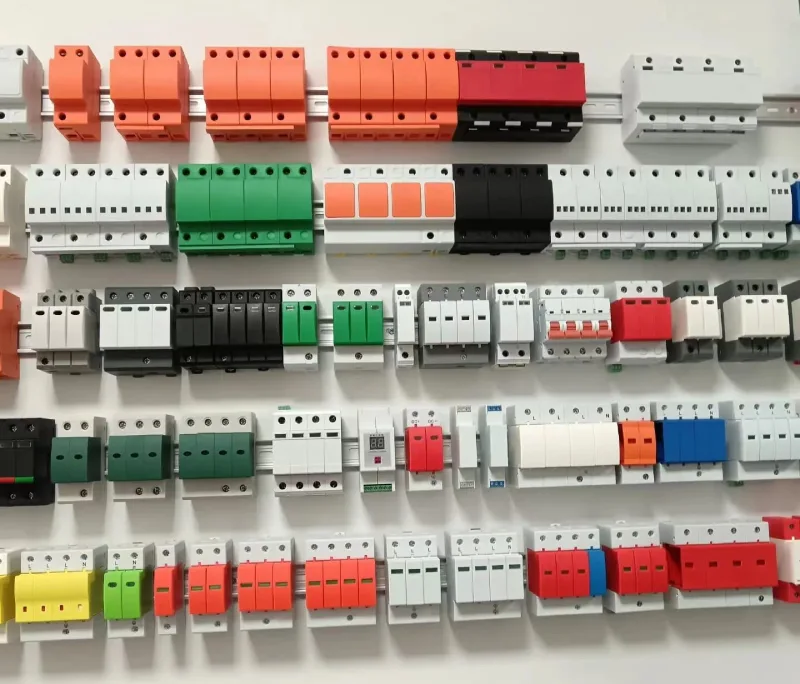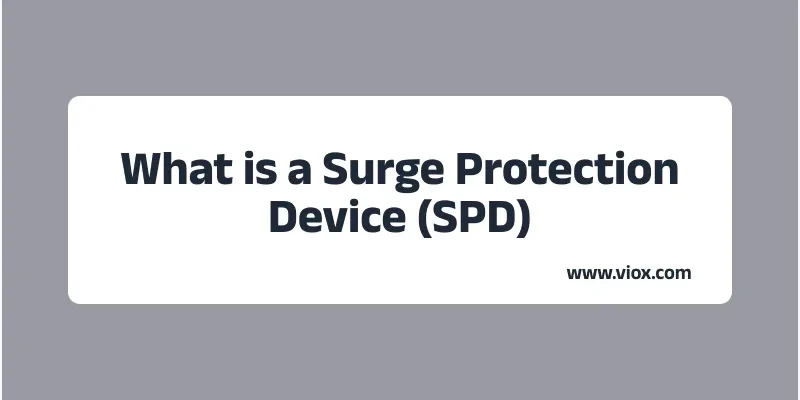A surge protection device (SPD) is an electrical safety component that protects equipment and electrical systems from voltage spikes caused by lightning, power grid switching, or electrical faults. SPDs automatically divert excess electrical energy to ground, preventing damage to sensitive electronics, appliances, and electrical infrastructure.
Understanding surge protection devices is critical for protecting your electrical investments, ensuring code compliance, and maintaining electrical safety in residential, commercial, and industrial applications.
What is a Surge Protection Device: Technical Definition

A surge protection device (SPD), also known as a surge protective device or transient voltage surge suppressor (TVSS), is an electrical component designed to protect electrical circuits and connected equipment from voltage transients and surges.
Key Technical Characteristics:
- Clamping voltage: The voltage level at which the SPD begins conducting
- Maximum continuous operating voltage (MCOV): Highest RMS voltage the device can handle continuously
- Surge current rating: Maximum current the device can safely divert (measured in kiloamperes)
- Response time: How quickly the device reacts to voltage spikes (typically nanoseconds to microseconds)
Types of Surge Protection Devices: Complete Classification
SPD Classifications by Installation Location
| SPD Type | Installation Location | Protection Level | Typical Applications |
|---|---|---|---|
| Type 1 (Class B) | Service entrance, between meter and main panel | Primary protection against direct lightning strikes | Main electrical panels, outdoor installations |
| Type 2 (Class C) | Main electrical panel, subpanels | Secondary protection against conducted surges | Distribution panels, branch circuits |
| Type 3 (Class D) | Point of use, individual outlets | Final protection for sensitive equipment | Electronic devices, computers, appliances |
SPD Classifications by Technology
Metal Oxide Varistor (MOV) SPDs:
- Most common residential and commercial type
- Fast response times (nanoseconds)
- Self-sacrificing technology
- Cost-effective for most applications
Gas Discharge Tube (GDT) SPDs:
- Higher surge current capacity
- Slower response times
- Longer lifespan
- Ideal for telecommunications applications
Silicon Avalanche Diode (SAD) SPDs:
- Fastest response times
- Precise clamping voltages
- Higher cost
- Best for sensitive electronic equipment
How Surge Protection Devices Work

SPDs operate on three fundamental principles:
- Voltage Monitoring: The device continuously monitors the electrical voltage on the protected circuit.
- Surge Detection: When voltage exceeds the device’s clamping threshold, internal components activate.
- Energy Diversion: Excess electrical energy is safely diverted to the grounding system, protecting downstream equipment.
Step-by-Step Surge Protection Process
- Normal Operation: SPD remains in high-impedance state, allowing normal current flow
- Surge Event: Lightning strike or electrical fault creates voltage spike
- Activation: SPD detects overvoltage condition and switches to low-impedance state
- Energy Diversion: Surge current flows through SPD to ground instead of protected equipment
- Reset: SPD returns to high-impedance state after surge passes
SPD Applications and Use Cases
Residential Applications
Whole-House Protection:
- Main electrical panel installation (Type 2 SPD)
- Protects all circuits and connected devices
- Required by many local electrical codes
- Typical surge rating: 40-80 kA per mode
Point-of-Use Protection:
- Individual outlet protection for sensitive electronics
- Computer workstations and home theaters
- Medical equipment and security systems
- Typical surge rating: 1-15 kA
Commercial and Industrial Applications
Critical Infrastructure Protection:
- Data centers and server farms
- Manufacturing equipment and controls
- Telecommunications installations
- Emergency power systems
Specific Industry Requirements:
- Healthcare facilities: Medical equipment protection
- Financial institutions: Data integrity protection
- Manufacturing: Process control system protection
- Telecommunications: Network equipment protection
SPD Selection Criteria: Expert Decision Framework

Essential Selection Factors
- 1. Voltage Rating Compatibility
- Match SPD voltage rating to system voltage
- Common ratings: 120V, 240V, 277V, 480V
- Ensure proper phase configuration (single-phase, three-phase)
- 2. Surge Current Capacity
- Type 1: 25-100 kA minimum per mode
- Type 2: 20-40 kA for residential, 40-160 kA for commercial
- Type 3: 1-15 kA for point-of-use applications
- 3. Response Time Requirements
- Critical applications: <1 nanosecond
- Standard applications: 1-25 nanoseconds
- Basic protection: 25+ nanoseconds
SPD Selection Table
| Application Type | Recommended SPD Type | Minimum Surge Rating | Key Features Required |
|---|---|---|---|
| Residential Main Panel | Type 2, MOV technology | 40 kA per mode | UL 1449 listing, visual indicators |
| Commercial Distribution | Type 2, MOV or hybrid | 80-160 kA per mode | Remote monitoring, replaceable modules |
| Industrial Critical Loads | Type 1 + Type 2 coordination | 100+ kA per mode | Fail-safe design, backup protection |
| Point-of-Use Electronics | Type 3, SAD or MOV | 1-6 kA | Low clamping voltage, EMI filtering |
Installation Requirements and Code Compliance
National Electrical Code (NEC) Requirements
⚠️ SAFETY WARNING: SPD installation must be performed by qualified electricians and inspected by local authorities.
Article 285 – Surge Protective Devices (SPDs):
- SPDs rated 1000V or less must be listed equipment
- Installation must follow manufacturer specifications
- Proper grounding and bonding required
- Disconnecting means may be required
Installation Best Practices
- Proper Grounding
- Use shortest practical conductor lengths (ideally <12 inches)
- Avoid sharp bends in grounding conductors
- Ensure solid connections to equipment grounding conductor
- Consider dedicated grounding electrode for Type 1 SPDs
- Coordination Between SPD Types
- Install Type 1 at service entrance when required
- Place Type 2 SPDs at distribution panels
- Use Type 3 SPDs for sensitive equipment protection
- Maintain proper electrical separation distances
- Monitoring and Maintenance
- Install SPDs with visual status indicators
- Consider remote monitoring for critical applications
- Establish regular inspection schedules
- Replace failed or degraded devices promptly
Expert Tips for Maximum Protection
💡 EXPERT TIP: Surge protection is most effective when implemented as a coordinated system, not individual devices.
Advanced Protection Strategies:
- Use multiple protection levels (Types 1, 2, and 3 coordination)
- Install SPDs as close as possible to protected equipment
- Consider EMI/RFI filtering for sensitive electronics
- Implement proper electrical isolation techniques
Common Installation Mistakes to Avoid:
- Excessive conductor lengths reducing effectiveness
- Inadequate grounding system connections
- Mixing incompatible SPD technologies
- Ignoring manufacturer spacing requirements
Troubleshooting and Maintenance
SPD Status Monitoring
Visual Indicators:
- Green LED: Device operational and protecting
- Red LED: Device compromised or failed
- No LED: Check power supply or replace device
Performance Testing:
- Annual insulation resistance testing
- Visual inspection of connections and indicators
- Verification of proper grounding continuity
- Documentation of test results for code compliance
When to Replace SPDs
Replacement Indicators:
- Failed status indicator
- Physical damage or overheating signs
- After significant surge events
- Manufacturer recommended service life exceeded
Quick Reference: SPD Selection Guide
Residential Quick Selection
| Protection Need | SPD Type | Installation Location | Typical Rating |
|---|---|---|---|
| Whole House | Type 2 MOV | Main electrical panel | 40-80 kA |
| Electronics | Type 3 MOV/SAD | Individual outlets | 1-6 kA |
| HVAC Equipment | Type 2 MOV | Equipment disconnect | 20-40 kA |
Commercial Quick Selection
| Facility Type | Primary Protection | Secondary Protection | Point-of-Use |
|---|---|---|---|
| Office Building | Type 2, 80 kA | Type 2, 40 kA | Type 3, 6 kA |
| Data Center | Type 1, 100 kA | Type 2, 160 kA | Type 3, 1 kA |
| Manufacturing | Type 1, 160 kA | Type 2, 80 kA | Type 3, 15 kA |
Frequently Asked Questions
What makes a surge protection device different from a power strip?
A true SPD is designed and tested specifically for surge protection with UL 1449 certification, proper clamping voltages, and adequate surge current capacity. Basic power strips often provide minimal or no actual surge protection.
How do I know if my SPD is working properly?
Most quality SPDs include visual status indicators (LED lights) showing operational status. Green typically means protecting, red means replace. If no indicator is present, the device should be tested by a qualified electrician.
Can I install an SPD myself?
Type 3 point-of-use SPDs can typically be installed by homeowners, but Type 1 and Type 2 devices require installation by licensed electricians due to electrical code requirements and safety considerations.
What size SPD do I need for my home?
For whole-house protection, a Type 2 SPD with 40-80 kA surge current rating is typically adequate for residential applications. Consult with a qualified electrician for specific recommendations based on your electrical system.
Do SPDs need to be replaced after a surge event?
Not necessarily. Quality SPDs are designed to handle multiple surge events. However, you should check status indicators and have the device inspected after any significant electrical event like nearby lightning strikes.
How long do surge protection devices last?
Typical SPD service life ranges from 5-10 years depending on technology, environmental conditions, and surge activity. Regular monitoring and replacement of failed indicators ensures continued protection.
What electrical codes apply to SPD installation?
The National Electrical Code (NEC) Article 285 governs SPD installations in the United States. Local codes may have additional requirements. Always verify current code requirements with local electrical authorities.
Should I use Type 1, Type 2, or Type 3 SPDs?
This depends on your specific application and local code requirements. Type 1 is for service entrance protection against direct lightning, Type 2 for distribution panel protection, and Type 3 for point-of-use protection. Many applications benefit from coordinated multi-level protection.
Professional Recommendations
When to Consult a Licensed Electrician:
- Any main panel or distribution panel SPD installation
- Determining proper SPD sizing and coordination
- Electrical system evaluation for surge protection needs
- Code compliance verification and inspection preparation
Certification and Training Requirements:
- Electricians must hold appropriate state licensing
- SPD manufacturers often provide specialized training
- Consider certified surge protection specialists for critical applications
- Regular continuing education on evolving code requirements
Surge protection devices are essential components of modern electrical safety systems. Proper selection, installation, and maintenance ensure reliable protection for your electrical investments while meeting code compliance requirements. For complex applications or critical systems, always consult with qualified electrical professionals to design and implement comprehensive surge protection strategies.
Related
How Surge Protective Devices (SPDs) Differ from Other Electrical Surge Protection Methods
How to Choose the Right SPD for Your Solar Power System


